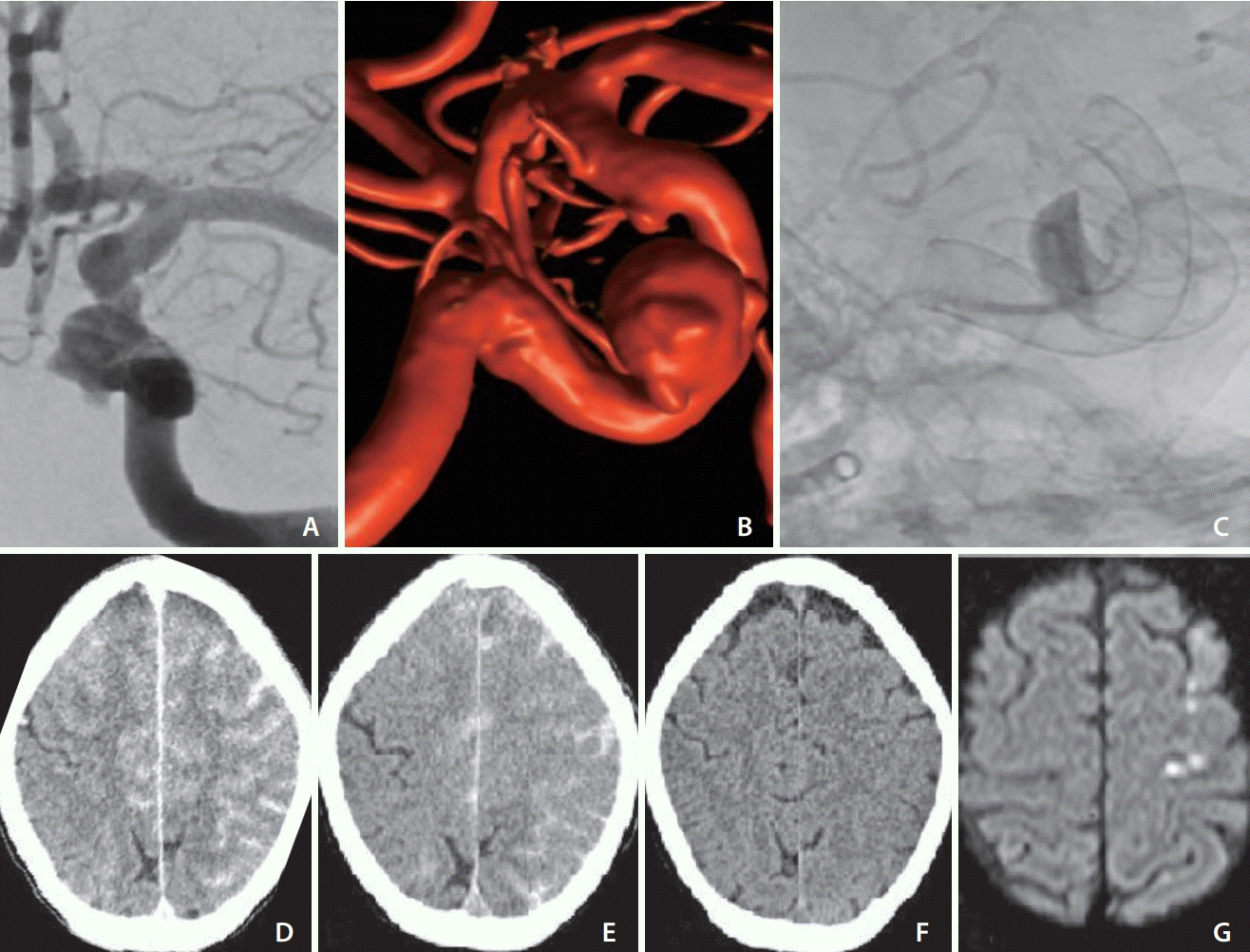1. Chu YT, Lee KP, Chen CH, Sung PS, Lin YH, Lee CW, et al. Contrast-induced encephalopathy after endovascular thrombectomy for acute ischemic stroke. Stroke. 2020; 51:3756–3759.

2. Potsi S, Chourmouzi D, Moumtzouoglou A, Nikiforaki A, Gkouvas K, Drevelegas A. Transient contrast encephalopathy after carotid angiography mimicking diffuse subarachnoid haemorrhage. Neurol Sci. 2012; 33:445–448.

3. Yu J, Dangas G. Commentary: new insights into the risk factors of contrast-induced encephalopathy. J Endovasc Ther. 2011; 18:545–546.

4. Leong S, Fanning NF. Persistent neurological deficit from iodinated contrast encephalopathy following intracranial aneurysm coiling. A case report and review of the literature. Interv Neuroradiol. 2012; 18:33–41.

5. Cristaldi PMF, Polistena A, Patassini M, de Laurentis C, Giussani C, Remida P. Contrast-induced encephalopathy and permanent neurological deficit: a case report and literature review. Surg Neurol Int. 2021; 12:273.

6. Lantos G. Cortical blindness due to osmotic disruption of the blood-brain barrier by angiographic contrast material: CT and MRI studies. Neurology. 1989; 39:567–571.

7. Uchiyama Y, Abe T, Hirohata M, Tanaka N, Kojima K, Nishimura H, et al. Blood brain-barrier disruption of nonionic iodinated contrast medium following coil embolization of a ruptured intracerebral aneurysm. AJNR Am J Neuroradiol 2004;25:1783-1786 Erratum in: AJNR Am J Neuroradiol. 2005; 26:203.
8. Liu MR, Jiang H, Li XL, Yang P. Case report and literature review on low-osmolar, non-ionic iodine-based contrast-induced encephalopathy. Clin Interv Aging. 2020; 15:2277–2289.
9. Iwata T, Mori T, Tajiri H, Miyazaki Y, Nakazaki M. Repeated injection of contrast medium inducing dysfunction of the bloodbrain barrier: case report. Neurol Med Chir (Tokyo). 2013; 53:34–36.

10. Vazquez S, Graifman G, Spirollari E, Ng C, Uddin A, Feldstein E, et al. Incidence and risk factors for acute transient contrast-induced neurologic deficit: a systematic review with meta-analysis. Stroke Vasc Interv Neurol. 2022; 2:e000142.

11. Kamimura T, Nakamori M, Imamura E, Hayashi Y, Matsushima H, Mizoue T, et al. Low-dose contrast-induced encephalopathy during diagnostic cerebral angiography. Intern Med. 2021; 60:629–633.

12. Eckel TS, Breiter SN, Monsein LH. Subarachnoid contrast enhancement after spinal angiography mimicking diffuse subarachnoid hemorrhage. AJR Am J Roentgenol. 1998; 170:503–505.

13. Spina R, Simon N, Markus R, Muller DW, Kathir K. Contrast-induced encephalopathy following cardiac catheterization. Catheter Cardiovasc Interv. 2017; 90:257–268.

14. Nagamine Y, Hayashi T, Kakehi Y, Yamane F, Ishihara S, Uchino A, et al. Contrast-induced encephalopathy after coil embolization of an unruptured internal carotid artery aneurysm. Intern Med. 2014; 53:2133–2138.

15. Zhao W, Zhang J, Song Y, Sun L, Zheng M, Yin H, et al. Irreversible fatal contrast-induced encephalopathy: a case report. BMC Neurol. 2019; 19:46.

16. Jang HW, Lee HJ. Posterior reversible leukoencephalopathy due to “triple H“ therapy. J Clin Neurosci. 2010; 17:1059–1061.

17. Giraldo EA, Fugate JE, Rabinstein AA, Lanzino G, Wijdicks EF. Posterior reversible encephalopathy syndrome associated with hemodynamic augmentation in aneurysmal subarachnoid hemorrhage. Neurocrit Care. 2011; 14:427–432.

18. Skolarus LE, Gemmete JJ, Braley T, Morgenstern LB, Pandey A. Abnormal white matter changes after cerebral aneurysm treatment with polyglycolic-polylactic acid coils. World Neurosurg. 2010; 74:640–644.

19. Allison C, Sharma V, Park J, Schirmer CM, Zand R. Contrast-induced encephalopathy after cerebral angiogram: a case series and review of literature. Case Rep Neurol. 2021; 13:405–413.

20. Lo LW, Chan HF, Ma KF, Cheng LF, Chan TK. Transient cortical blindness following vertebral angiography: a case report. Neurointervention. 2015; 10:39–42.

21. Meijer FJA, Steens SCA, Tuladhar AM, van Dijk ED, Boogaarts HD. Contrast-induced encephalopathy-neuroimaging findings and clinical relevance. Neuroradiology. 2022; 64:1265–1268.

22. Matsubara N, Izumi T, Miyachi S, Ota K, Wakabayashi T. Contrast-induced encephalopathy following embolization of intracranial aneurysms in hemodialysis patients. Neurol Med Chir (Tokyo). 2017; 57:641–648.

23. Niimi Y, Kupersmith MJ, Ahmad S, Song J, Berenstein A. Cortical blindness, transient and otherwise, associated with detachable coil embolization of intracranial aneurysms. AJNR Am J Neuroradiol. 2008; 29:603–607.

24. Andone S, Balasa R, Barcutean L, Bajko Z, Ion V, Motataianu A, et al. Contrast medium-induced encephalopathy after coronary angiography- case report. J Crit Care Med (Targu Mures). 2021; 7:145–149.

25. Shinoda J, Ajimi Y, Yamada M, Onozuka S. Cortical blindness during coil embolization of an unruptured intracranial aneurysm--case report. Neurol Med Chir (Tokyo). 2004; 44:416–419.






 PDF
PDF Citation
Citation Print
Print



 XML Download
XML Download